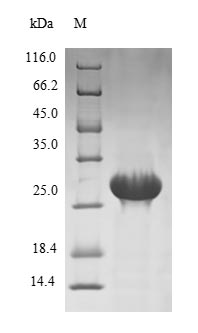Recombinant Human Testisin (PRSS21) is expressed in E. coli and covers the full length of the mature protein from amino acids 42 to 288. The protein includes an N-terminal 6xHis tag that makes purification and detection more straightforward. SDS-PAGE analysis shows the product achieves greater than 90% purity, which appears to meet quality standards for research work. This is strictly a research-use-only product and should not be used for clinical or diagnostic purposes.
Testisin, known by the gene symbol PRSS21, is a serine protease that's mainly expressed in the male reproductive tract. It seems to play an important role in reproductive biology and cellular processes like proteolytic cascades. Researchers find testisin particularly interesting for studying cellular mechanisms and pathways involved in spermatogenesis and related biological functions. This likely makes it a useful tool for research in developmental biology and reproductive health, though the full scope of its functions may still be emerging.
Potential Applications
Note: The applications listed below are based on what we know about this protein's biological functions, published research, and experience from experts in the field. However, we haven't fully tested all of these applications ourselves yet. We'd recommend running some preliminary tests first to make sure they work for your specific research goals.
The human Testisin is a serine protease that requires correct folding, disulfide bond formation, and potential glycosylation for enzymatic activity. E. coli, as a prokaryotic system, lacks eukaryotic chaperones and cannot perform glycosylation, making proper folding unlikely. The His tag may sterically interfere with the active site or protein interactions. Without experimental validation (e.g., protease activity assays), the protein cannot be assumed to be correctly folded or bioactive.
1. Protein-Protein Interaction Studies Using His-Tag Pull-Down Assays
The His tag enables pull-down assays to identify binding partners, but if Testisin is misfolded, interactions may be non-physiological. The tag itself could cause artifactual binding. Validate any identified partners using native Testisin from eukaryotic sources (e.g., mammalian cells) to ensure relevance. Confirm protein folding before use.
2. Antibody Development and Validation
This application is suitable. The recombinant Testisin can serve as an immunogen for generating antibodies against linear epitopes, even if misfolded. The high purity supports consistent immunization. However, antibodies generated may not recognize conformational epitopes of native, correctly folded Testisin. Validate antibody specificity against endogenous Testisin in human tissues or cell lines.
3. Biochemical Characterization and Substrate Specificity Analysis
This application requires confirmed enzymatic activity. If Testisin is verified to be active (e.g., via protease assays with synthetic substrates), it can be used for kinetic studies and substrate specificity mapping. Without activity validation, data on enzyme kinetics are unreliable. First, perform a functional assay to confirm protease activity.
4. Inhibitor Screening and Development
Inhibitor screening is only feasible if Testisin is bioactive. An inactive protein will not yield meaningful results for inhibitor identification. Validate protease activity before high-throughput screening. The His tag facilitates immobilization, but ensures it does not interfere with inhibitor binding.
Final Recommendation & Action Plan
Before using this recombinant Testisin for any functional application, prioritize experimental validation of its folding and bioactivity. Start with a protease activity assay using a fluorogenic or chromogenic substrate (e.g., Z-FR-AMC) to confirm enzymatic function. If active, proceed with interaction, kinetic, or inhibitor studies; if inactive, limit use to non-functional applications like antibody production (with validation against native Testisin). For reliable results, consider expressing Testisin in a eukaryotic system (e.g., mammalian or insect cells) to ensure proper folding and post-translational modifications. Always include appropriate controls, such as native Testisin or known inhibitors, to ensure biological relevance.






